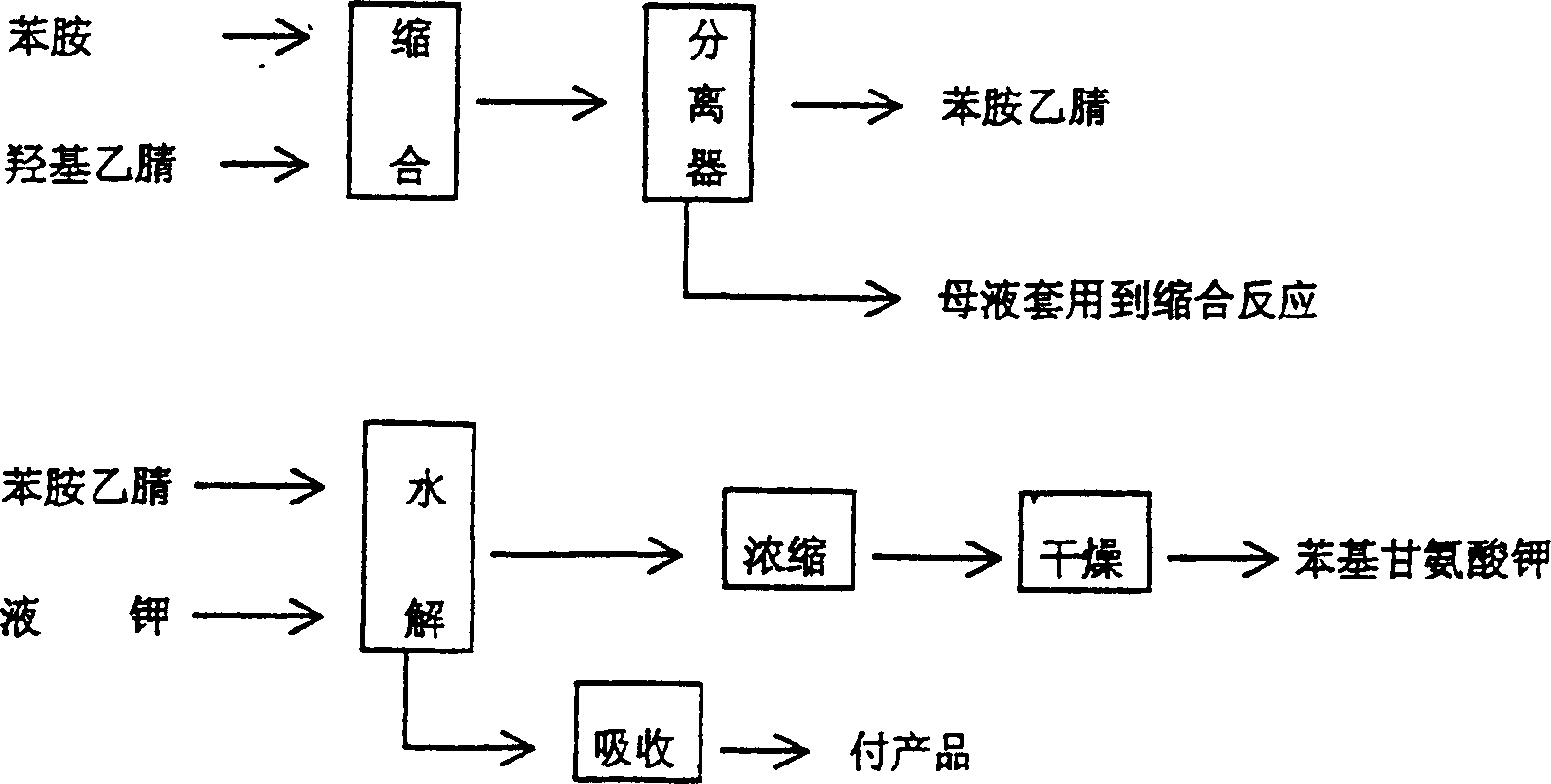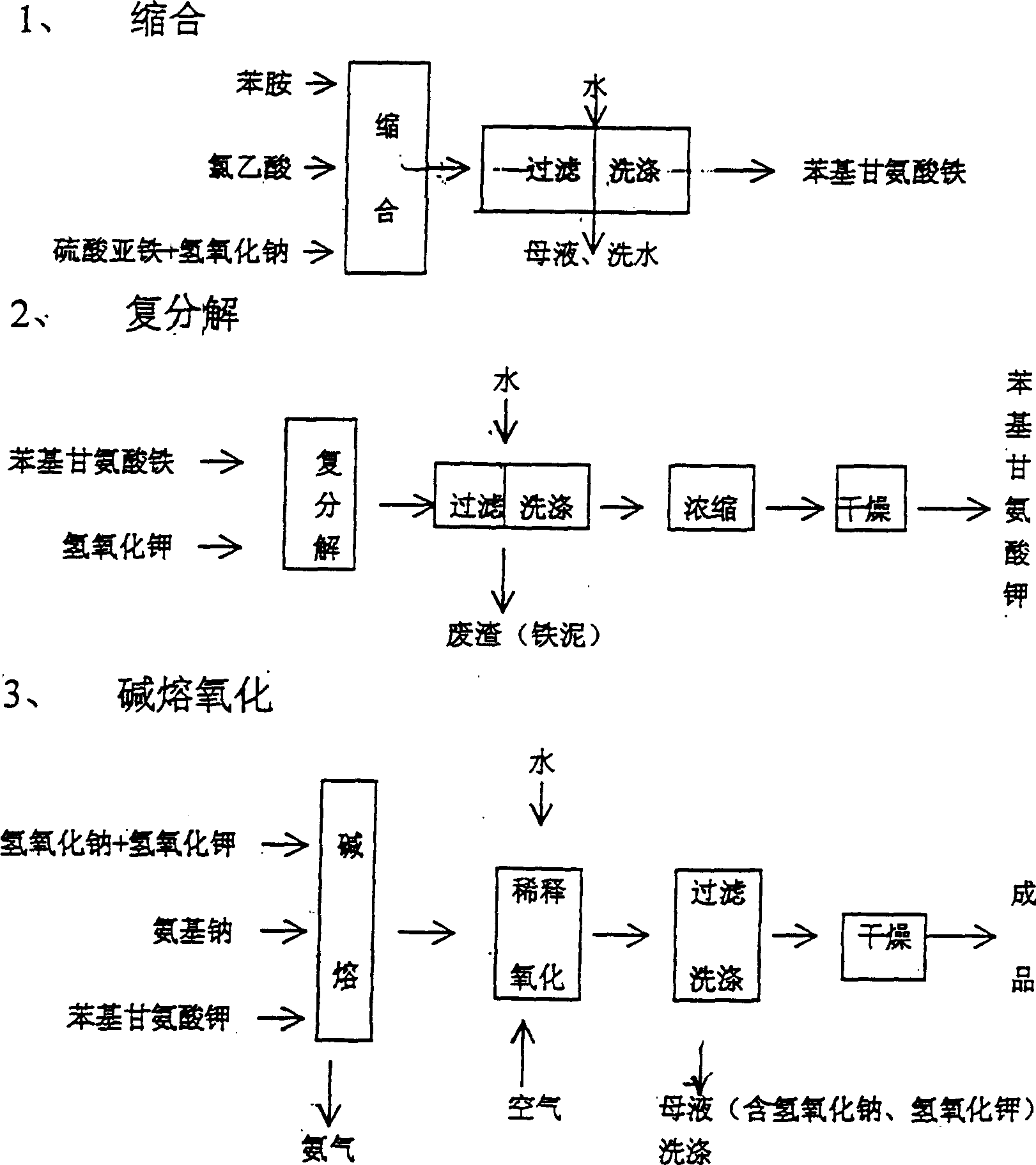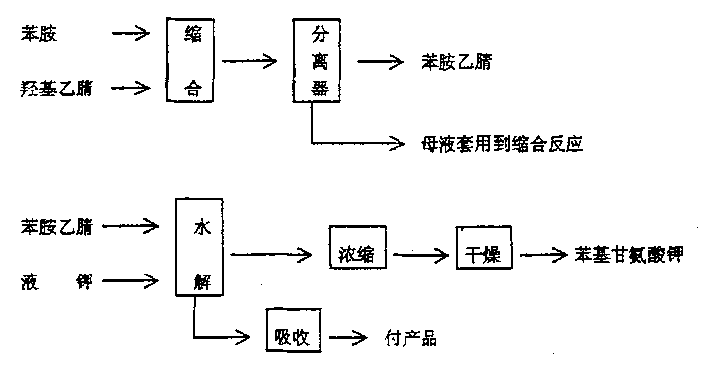Method for producing indigo
A production method and technology for indigo, applied in the field of condensation and hydrolysis reaction of the first two parts in the production of indigo, can solve problems such as restricting the development of production enterprises, difficult disposal of waste residues, affecting environmental protection, etc., to simplify production processes and reduce energy consumption. , the effect of pure shade
- Summary
- Abstract
- Description
- Claims
- Application Information
AI Technical Summary
Problems solved by technology
Method used
Image
Examples
Embodiment 1
[0013] Put aniline and hydroxyacetonitrile in the condensation reactor with a molar ratio of 1:0.95, react at 65-101 degrees Celsius, after 7 hours of reaction, put all the reaction materials into the separator for static layering, Put the oil in the lower layer in the separator into the crystallization tank to solidify, until the content of aniline acetonitrile reaches more than 92%, it can be directly put into the hydrolysis reactor, and the supernatant in the separator is placed in the condensation reactor; the liquid potassium and aniline Acetonitrile is put into reactor with the metering of 1: 0.95 with molar ratio, carries out hydrolysis reaction under boiling and having reflux, and the ammonia gas that reaction discharges adopts concentration to be absorbed by the dilute sulfuric acid of 20%, until no longer in hydrolysis reactor. Until the ammonia gas is discharged, the obtained reaction materials are concentrated and dried to obtain slightly yellow powdered potassium p...
Embodiment 2
[0015] Use a metering tank to place aniline and hydroxyacetonitrile in the condensation reactor at a molar ratio of 1:1.1, react at 70-101 degrees Celsius, and after 6 hours of reaction, put all the reaction materials into the separator for static Stratification, put the lower layer oil in the separator into the crystallization tank to solidify, until the content of aniline acetonitrile reaches more than 91%, it can be directly put into the hydrolysis reactor, and then put the supernatant in the separator into the condensation reactor; The tank puts liquid potassium and aniline acetonitrile into the hydrolysis reactor in a molar ratio of 1:1:1, carries out the hydrolysis reaction under boiling and reflux, and adopts 25% dilute hydrochloric acid to absorb the ammonia gas discharged from the reaction. Until the ammonia gas is no longer discharged in the hydrolysis reactor, the obtained reaction material is finally concentrated and dried to obtain white flake potassium phenylglyci...
Embodiment 3
[0017] At normal temperature, 684 kilograms of hydroxyacetonitrile with a content of 50.1% were measured and put into a 4000 liter condensation reaction pot, then 1800 kilograms of tap water was added, and 530 kilograms of aniline with a content of 99.6% was added after stirring for 15 minutes, and after stirring for 15 minutes , open the steam valve, heat slowly, keep warm at 55-60 degrees Celsius for 1.5 hours, then raise the temperature to 85 degrees Celsius, and keep warm at this temperature for 6 hours, the condensation reaction is over, then let the reaction materials stand still for 25 minutes , put the oily aniline acetonitrile in the lower layer into the crystallization tank, break the package and measure after crystallization, and put the supernatant liquid into the storage tank to cool and use it as condensation feeding water; put 837 kilograms of aniline acetonitrile into 6000 liters of hydrolysis tank with a content of 94.5%. Reactor, and add 2000 kg of tap water, ...
PUM
 Login to View More
Login to View More Abstract
Description
Claims
Application Information
 Login to View More
Login to View More - R&D
- Intellectual Property
- Life Sciences
- Materials
- Tech Scout
- Unparalleled Data Quality
- Higher Quality Content
- 60% Fewer Hallucinations
Browse by: Latest US Patents, China's latest patents, Technical Efficacy Thesaurus, Application Domain, Technology Topic, Popular Technical Reports.
© 2025 PatSnap. All rights reserved.Legal|Privacy policy|Modern Slavery Act Transparency Statement|Sitemap|About US| Contact US: help@patsnap.com



